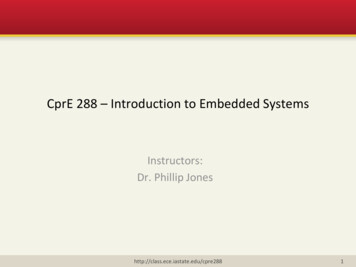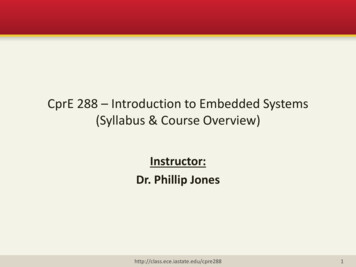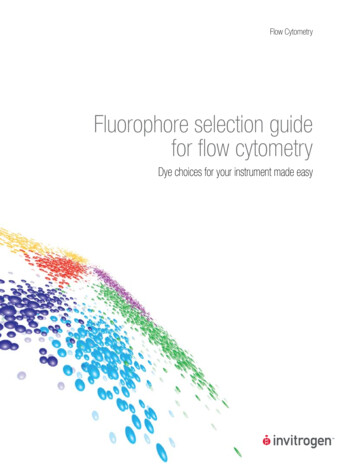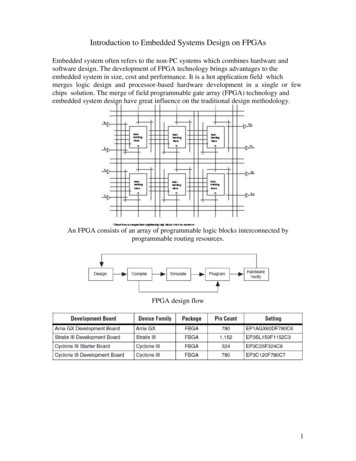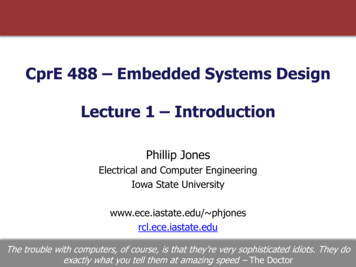
Transcription
CprE 488 – Embedded Systems DesignLecture 1 – IntroductionPhillip JonesElectrical and Computer EngineeringIowa State Universitywww.ece.iastate.edu/ phjonesrcl.ece.iastate.eduThe trouble with computers, of course, is that they’re very sophisticated idiots. They doexactly what you tell them at amazing speed – The Doctor
What is an Embedded System?(CPRE 288 reminder)Quadcopter Your Definition?Micro SD Card? What are some propertiesof an Embedded System?Blu-Ray / RemoteJones, Spring 2019 ISUProgrammableThermostatRoombaCprE 488 (Introduction)Lect-01.2
What is an Embedded System?(CPRE 288 reminder)Quadcopter Your Definition?Micro SD Card? What are some propertiesof an Embedded System?Blu-Ray / RemoteJones, Spring 2019 ISUProgrammableThermostatRoombaCprE 488 (Introduction)Lect-01.3
What is an Embedded System? The textbook definitions all have their limits An embedded system is simultaneously:1. “a digital system that provides service as part of alarger system” – G. De Micheli2. “any device that includes a programmable computerbut is not itself a general-purpose computer” – M.Wolf3. “a less visible computer” - E. Lee4. “a single-functioned, tightly constrained, reactivecomputing system” – F. Vahid5. “a computer system with a dedicated function withina larger mechanical or electrical system, often withreal-time computing constraints” – WikipediaJones, Spring 2019 ISUCprE 488 (Introduction)Lect-01.4
Perspective Matters! These definitions quickly become blurredwhen changing perspective:Part of a larger system:Not general-purpose:Less visible:Tightly constrained:Dedicated function:Jones, Spring 2019 ISUCprE 488 (Introduction)Lect-01.5
Another Practical Definition An embedded system is a computing system that uses an ARMprocessor Multiple caveats:– There is a significant 8-bit embedded market as well (e.g. PIC, Atmel,8051)– ARM is also attempting to grow into the desktop and server marketJones, Spring 2019 ISUCprE 488 (Introduction)Lect-01.6
A Different Paradigm Cyber-Physical System (CPS): an integration ofcomputation with physical processes– Embedded computers monitor and control the physicalprocesses– Feedback loops – physical processes affect computation,and vice versa Examples tend to include networks of interacting components(as opposed to standalone embedded devices) Still a matter of perspective as networks can span continents or beenclosed in a single chipJones, Spring 2019 ISUCprE 488 (Introduction)Lect-01.7
Scale of Embedded Devices Even as Electrical and Computer Engineers it can beeasy to understate the scale (both in terms of sizeand ubiquity) of embedded devices SanDisk microSD card 100 MHz ARM CPU But for what reason?Jones, Spring 2019 ISU Apple Lightning Digital AV Adapter 256 MB DDR2, ARM SoCCprE 488 (Introduction)Lect-01.8
This Course’s Focus Embedded system design – the methodologies, tools, and platformsneeded to model, implement, and analyze modern embeddedsystems:– Modeling – specifying what the system is supposed to do– Implementation – the structured creation of hardware and softwarecomponents– Analysis – understanding why the implementation matches (or fails tomatch) the model– Design is not just hacking things together (which is admittedly also fun) What makes embedded system design uniquely challenging?– System reliability needs: Can’t crash, may not be able to reboot Can’t necessarily receive firmware / software updates– System performance and power constraints: Real-time issues in many applications (Potentially) limited memory and processing power– System cost: Fast time to market on new products Typically very cost competitiveJones, Spring 2019 ISUCprE 488 (Introduction)Lect-01.9
CprE 488 Survival SkillsNecessary SkillGained FromSoftware Development (General)ComS 207/227, EE 285PointersPointersCprE 288Memory and Peripheral InterfacingCprE 288CPU ArchitectureCprE 381HDL DesignCprE 381Circuits and SignalsEE 230, EE 224Critical ThinkingYour ParentsPlanning and Hard WorkYour Parents Any course that claims to teach you how to design embeddedsystems is somewhat misleading you, as the technology willcontinue to undergo rapid change Our goal: provide a fundamental understanding of existing designmethodology coupled with some significant experience on acurrent state-of-the-art platformJones, Spring 2019 ISUCprE 488 (Introduction)Lect-01.10
CprE 488 – Meet the StaffRobert WernsmanProf. Phillip Jonesphjones@iastate.eduOffice Hours: TBA (329 Durham)InstructorJames Talbertcpre488-tas@iastate.eduOffice Hours: TBA (Lab)TeachingAssistantsJones, Spring 2019 ISUCprE 488 (Introduction)Lect-01.11
CprE 488 – Resources Main text: M. Wolf. Computers asComponents (4th edition): Principles ofEmbedded Computing System Design,Morgan Kaufmann, 2017. We are here to help, but communication is key! Key online resources:– Class webpage: class.ece.iastate.edu/cpre488 – containslecture notes, assignments, documentation, generalschedule information (Note: HW0 is due this Friday!!)– Canvas space: https://canvas.iastate.edu is heavily usedfor announcements, discussion, online submission, grading– Class wiki: wikis.ece.iastate.edu/cpre488 – updated (byyou!) to include general tips and tricks and projectphotos/videosJones, Spring 2019 ISUCprE 488 (Introduction)Lect-01.12
Weekly Layout (Office hours to add)MondayTuesdayWednesdayThursdayFriday9 amLab A(2041 Coover)10 00Lab C(2041 Coover)11 0012 pm1 00Lecture(1126 Sweeney)Lecture(1126 Sweeney)2 003 004 00Lab B(2041 Coover) 7 00Jones, Spring 2019 ISUCprE 488 (Introduction)Lect-01.13
FPGA Design Tools Necessary steps (scripts will be provided to help automate):1.2.Login to any of the departmental Linux machines: Remote access to machines on the list here:http://it.engineering.iastate.edu/remote/ Use Cygwin/X (ssh), NX client (preferred if the machine supports it) Some extra machines connected to FPGA boards if you really need themFrom the bash shell, enter the following:source /remote/Xilinx/14.6/settings64.shexport PATH PATH:/remote/Modelsim/10.1c/modeltech/linux x86 64/export LM LICENSE FILE nes, Spring 2019 ISUCprE 488 (Introduction)Lect-01.14
Lecture Topic Outline Lect-01: Lect-02: Lect-03: Lect-04: Lect-05: Lect-06: Lect-07: Lect-08:IntroductionEmbedded PlatformsProcessors and MemoryInterfacing TechnologiesSoftware OptimizationAccelerator DesignEmbedded Control SystemsEmbedded OSJones, Spring 2019 ISUCprE 488 (Introduction)Lect-01.15
Machine Problems (MPs) 5 team-based, applied assignments– Graded on completeness and effort– Significant hardware and software components– Two weeks each, with in-class and in-lab demos Tentative agenda:– MP-0:– MP-1:– MP-2:– MP-3:– MP-4:Platform IntroductionQuad UAV InterfacingDigital CameraTarget AcquisitionUAV ControlJones, Spring 2019 ISUCprE 488 (Introduction)Lect-01.16
Course Project Student-proposed, student-assessed embedded systemdesign project Essentially a capstone project – integrating yourknowledge in digital logic, programming, and systemdesign Something reasonable in a 5-6 week timeframe, likelyleveraging existing lab infrastructure Deliverables:– Project proposal presentation and assessment rubric (week 9)– Project presentation and demo (10 minutes, week 16)– Project page on class wiki, with images / video (continuous)Jones, Spring 2019 ISUCprE 488 (Introduction)Lect-01.17
Grading Policies Grade components:–––––Machine Problems [5x]HomeworkClass ParticipationMidterm Exams [2x]Final Project(40%)(10%)(5%)(30%)(15%) At first glance, CprE 488 appears to be quite a bit of work!– Yes. Yes it is. – The lab/final project component is probably the most important– If you are a valuable member of your lab team, you will get an A Our goals as your instructor:– To create a fun, yet challenging, collaborative learning environment– To motivate the entire class to a 4.0 GPA– To inspire you to learn more (independent study / MS thesis ideas?)Jones, Spring 2019 ISUCprE 488 (Introduction)Lect-01.18
Some High-Level Challenges How much hardware do we need?– How fast is the CPU? How large is Memory? How do we meet our deadlines?– Faster hardware or cleverer software? How do we minimize power?– Turn off unnecessary logic?– Reduce memory accesses?– Data compression? Multi-objective optimization in a vast design spaceJones, Spring 2019 ISUCprE 488 (Introduction)Lect-01.19
Design Considerations: Mars RoversMars Sojourner Rover (1997)– About 25 pounds– 25 x 19 x 12 inches– 8-bit Intel 80C85 100 KHzOpportunity/ Spirit (2004)– About 400 pounds– 5.2 x 7.5 x 4.9 ft– 32-bit Rad6000 20 MHz cost: ?Jones, Spring 2019 ISUCprE 488 (Introduction)Lect-01.20
Some High-Level Challenges How much hardware do we need?– How big is the CPU? Memory? How do we meet our deadlines?– Faster hardware or cleverer software? How do we minimize power?– Turn off unnecessary logic?– Reduce memory accesses?– Data compression? Multi-objective optimization in a vast design spaceJones, Spring 2019 ISUCprE 488 (Introduction)Lect-01.21
Some High-Level Challenges How much hardware do we need?– How big is the CPU? Memory? How do we meet our deadlines?– Faster hardware or cleverer software? How do we minimize power?– Turn off unnecessary logic?– Reduce memory accesses?– Data compression? Multi-objective optimization in a vast design spaceJones, Spring 2019 ISUCprE 488 (Introduction)Lect-01.22
System Constraints and Considerations Exploring Martian surface (Power consumption)– Movement– Communications– ComputationJones, Spring 2019 ISUCprE 488 (Introduction)Lect-01.23
Energy / Power Quadcopter Battery– Capacity: 2000mAh– Max current: 35C, 7.4V– Quad On average requires 20A Average Watts required? Average Flight time?Jones, Spring 2019 ISUCprE 488 (Introduction)Lect-01.24
Energy / Power Quadcopter Battery– Capacity: 2000mAh– Max current: 35C, 7.4V– Quad On average requires 20A 20A * 7.4V 148 W 2000/20,000 .1 hr 6 minJones, Spring 2019 ISUCprE 488 (Introduction)Lect-01.25
System Constraints and Considerations Exploring Martian surface (Power consumption)– Movement: (?)– Communications: (?)– Computation: (?) Power Available– Solar panels (140W, 4-hours/day)– Battery storageJones, Spring 2019 ISUCprE 488 (Introduction)Lect-01.26
System Constraints and Considerations Exploring Martian surface (Power consumption)– Movement: 100 W– Communications: Rover-Orbiter (5W), Rover-Earth (100W)– Computation: 20W@20Mhz, 5W@2.5MHz Power Available– Solar panels (140W, 4-hours/day)– Battery storageJones, Spring 2019 ISUCprE 488 (Introduction)Lect-01.27
System Constraints and Considerations Exploring Martian surface (Power consumption)– Movement: 100 W– Communications: Rover-Orbiter (5W), Rover-Earth (100W)– Computation: 20W@20Mhz, 5W@2.5MHz Power Available– Solar panels (140W, 4-hours/day) Capabilities– 3,500 – 12,000 bit/s to Earth– 120,000 bit/s to OrbiterJones, Spring 2019 ISUCprE 488 (Introduction)Lect-01.28
System Constraints and Considerations Exploring Martian surface (Power consumption)– Movement: 100 W– Communications: Rover-Orbiter (5W), Rover-Earth (100W)– Computation: 20W@20Mhz, 5W@2.5MHz Power Available– Solar panels (140W, 4-hours/day) Capabilities– 3,500 – 12,000 bit/s to Earth– 120,000 bit/s to Orbiter Task– Image transmission:1024x1024 12-bit-pixelsJones, Spring 2019 ISUCprE 488 (Introduction)Lect-01.29
Image transmission Communicating with Earth or Orbiter– Communications: Rover-Orbiter (5W), Rover-Earth (100W) 100,000 bits/s to Obiter 10,000 bit/s to Earth– Computation: 20W@20Mhz, 5W@2.5MHz– Image Size: 1000x1000 10-bit-pixels Constraints– 3 hour window/day for Earth transmission– 10 min widow/day for Obiter transmission Compute– Time to send 1 image to Earth, to Obiter– How many pics per day (Earth and Obiter)Jones, Spring 2019 ISUCprE 488 (Introduction)Lect-01.30
Image transmission Communicating with Earth or Orbiter– Communications: Rover-Orbiter (5W), Rover-Earth (100W) 100,000 bits/s to Obiter 10,000 bit/s to Earth– Computation: 20W@20Mhz, 5W@2.5MHz– Image Size: 1000x1000 10-bit-pixels Constraints– 3 hour window/day for Earth transmission– 10 min widow/day for Obiter transmission Compute– Time to send 1 image to Earth, to Obiter– How many pics per day (Earth and Obiter)ChannelPower Time/ Energy/(W J/s) pic (s) pic (J)Rov- OrbRov- EarthTime/ Picsday (s) /day560010010,000Jones, Spring 2019 ISUEnergy/day (J)CprE 488 (Introduction)Lect-01.31
Image transmission Communicating with Earth or Orbiter– Communications: Rover-Orbiter (5W), Rover-Earth (100W) 100,000 bits/s to Obiter 10,000 bit/s to Earth– Computation: 20W@20Mhz, 5W@2.5MHz– Image Size: 1000x1000 10-bit-pixels Constraints– 3 hour window/day for Earth transmission– 10 min widow/day for Obiter transmission Compute– Time to send 1 image to Earth, to Obiter– How many pics per day (Earth and Obiter)ChannelPower Time/ Energy/(W J/s) pic (s) pic (J)Rov- OrbRov- EarthTime/ Picsday (s) /dayEnergy/day 0Jones, Spring 2019 ISUCprE 488 (Introduction)Lect-01.32
Image transmission Communicating with Earth or Orbiter (5,000 J / day budget)– Communications: Rover-Orbiter (5W), Rover-Earth (100W) 100,000 bits/s to Obiter 10,000 bit/s to Earth– Computation: 20W@20Mhz, 5W@2.5MHz– Image Size: 1000x1000 10-bit-pixels Constraints– 3 hour window/day for Earth transmission– 10 min widow/day for Obiter transmission Compute– Time to send 1 image to Earth, to Obiter– How many pics per day (Earth and Obiter)ChannelPower Time/ Energy/(W J/s) pic (s) pic (J)Rov- OrbRov- EarthTime/ Picsday (s) /dayEnergy/day 0Jones, Spring 2019 ISUCprE 488 (Introduction)Lect-01.33
Image transmission Communicating with Earth or Orbiter (5,000 J / day budget)– Communications: Rover-Orbiter (5W), Rover-Earth (100W) 100,000 bits/s to Obiter 10,000 bit/s to Earth– Computation: 20W@20Mhz, 5W@2.5MHz– Image Size: 1000x1000 10-bit-pixels Constraints– 3 hour window/day for Earth transmission– 10 min widow/day for Obiter transmission How could you get a better image rate?ChannelPower Time/ Energy/(W J/s) pic (s) pic (J)Rov- OrbRov- EarthTime/ Picsday (s) /dayEnergy/day 0Jones, Spring 2019 ISUCprE 488 (Introduction)Lect-01.34
Image transmission Communicating with Earth or Orbiter (5,000 J / day budget)– Communications: Rover-Orbiter (5W), Rover-Earth (100W) 100,000 bits/s to Obiter (10 min), 10,000 bit/s to Earth (3 hr)– Computation: 20W@20Mhz, 5W@2.5MHz– Image Size: 1000x1000 10-bit-pixels 10,000,000 bits/image Compression: ICER (Compression Incremental cost-effectivenessRatio): 1 bit/pixel– 1,000,000 bits/image Compress 1/pixel per clock.– How long to compress 1 image?– How much Energy to compress 1 image?ChannelPower Time/ Energy/(W J/s) pic (s) pic (J)Rov- OrbRov- EarthTime/ Picsday (s) /dayEnergy Comp time Comp Eng/day (J)/pic (s)/pic 0Jones, Spring 2019 ISUCprE 488 (Introduction)Lect-01.35
Image transmission Communicating with Earth or Orbiter (5,000 J / day budget)– Communications: Rover-Orbiter (5W), Rover-Earth (100W) 100,000 bits/s to Obiter (10 min), 10,000 bit/s to Earth (3 hr)– Computation: 20W@20Mhz, 5W@2.5MHz– Image Size: 1000x1000 10-bit-pixels 10,000,000 bits/image Compression: ICER (Compression Incremental cost-effectivenessRatio): 1 bit/pixel– 1,000,000 bits/image Compress 1/pixel per clock.– How long to compress 1 image?– How much Energy to compress 1 image?ChannelPower Time/ Energy/(W J/s) pic (s) pic (J)Rov- OrbRov- EarthTime/ Picsday (s) /dayEnergy Comp time Comp Eng/day (J)/pic (s)/pic (J)510050060063,000.05 / .41/21001,000100,00010,000101,000,000.05 / .41/2Jones, Spring 2019 ISUCprE 488 (Introduction)Lect-01.36
Illustrative Design Exercise An illustrative example of embedded systemdesign inspired by Chapter 1 of the M. WolftextbookGPS Navigation UnitJones, Spring 2019 ISUCprE 488 (Introduction)Lect-01.37
Major Steps in the Design ProcessJones, Spring 2019 ISUCprE 488 (Introduction)Lect-01.38
Abstraction LevelsunstructuredStructureHigh abstractionImplementation Detailphysical layoutuntimedTimingreal timeSpatial orderTemporal orderLow abstractionJones, Spring 2019 ISUCprE 488 (Introduction)Lect-01.39
Abstraction Levels [cont]requirementspure functionalProduct planningSpecificationconstraintsuntimedSystem Designbus functionaltiming accurateArchitectureProcessor DesignRTL / ISAImplementationcycle accurateLogic Designgatesgate delaysStructureJones, Spring 2019 ISUTimingCprE 488 (Introduction)Lect-01.40
Abstraction Levels [cont] Growing system complexities Move to higher levels of abstraction [ITRS07, itrs.net] Electronic system-level (ESL) stem levelSystemlevelNumber of componentsAbstractionLevel1E6Transistor1E7Source: R. Doemer, UC IrvineJones, Spring 2019 ISUCprE 488 (Introduction)Lect-01.41
Major Steps in the Design ProcessGPS Navigation UnitJones, Spring 2019 ISUCprE 488 (Introduction)Lect-01.42
Requirements Plain language description of what the userwants and expects to get May be developed in several ways:– Talking directly to customers (User Research)– Talking to marketing representatives– Providing prototypes to users for commentJones, Spring 2019 ISUCprE 488 (Introduction)Lect-01.43
Functional vs. Non-Functional Requirements Functional requirements:– output as a function of input Non-functional requirements:– time required to compute output;– size, weight, etc.;– power consumption;– reliability;– etc.Jones, Spring 2019 ISUCprE 488 (Introduction)Lect-01.44
GPS Navigation Unit Requirements Example: Table for summarizing metrics of interestJones, Spring 2019 ISUCprE 488 (Introduction)Lect-01.45
GPS Navigation Unit Requirements Functionality: Hand held. Show major roads & landmarks. User interface: At least 400 x 600 pixel screen. Threebuttons max. Pop-up menu. Performance: Map should scroll smoothly. No more than 1sec power-up. Lock onto GPS within 15 seconds. Cost: 120 street price approx. 40 cost of goods sold. Physical size/weight: Should fit in hand Power consumption: Should run for 8 hours on four AAbatteries Any others?Jones, Spring 2019 ISUCprE 488 (Introduction)Lect-01.46
Requirements: Summary & PrototypeJones, Spring 2019 ISUCprE 488 (Introduction)Lect-01.47
Major Steps in the Design ProcessGPS Navigation UnitJones, Spring 2019 ISUCprE 488 (Introduction)Lect-01.48
GPS Specification What should system include:– What is received from GPS;– Map data;– User interface;– Operations required to satisfy user requests;– Background operations needed to keep the systemrunning Often described using mechanisms such as:– UML– Data/Control Flow diagrams, Compute Model (FSM)– Formal Method language (1st order logic, LTL)Jones, Spring 2019 ISUCprE 488 (Introduction)Lect-01.49
System Specification Capture requirementsNatural language Ambiguous– Functional Incomplete Free of any implementation details– Non-functional Quality metrics, constraints Formal representationd– Models of computationP3C1P1d Allow analysis of propertiesP2P4C2– Executable Can validate using simulation Can verify with formal methods Used for application development– Precise description of desired system behaviorJones, Spring 2019 ISUCprE 488 (Introduction)P5Lect-01.50
Major Steps in the Design ProcessGPS Navigation UnitJones, Spring 2019 ISUCprE 488 (Introduction)Lect-01.51
System ArchitectureCPU– ProcessorsArbiter General-purpose, programmable Digital signal processors (DSPs) Application-specific instructionset processor (ASIP) Custom hardware processors Intellectual property (IP)P1P3CPU BusP2– MemoriesMemC1, C2Bridge Processing elements (PEs)C1, C2P5P4HWIP BusIP Communication elements (CEs)– Transducers, bus bridges– I/O peripherals Busses– Communication media Parallel, master/slave protocols Serial and network mediaJones, Spring 2019 ISU Heterogeneous multiprocessor systems Multi-Processor Systemon-Chip (MPSoC)CprE 488 (Introduction)Lect-01.52
GPS Unit System Architecture (Diagram)GPSreceiversearchenginedatabaseJones, Spring 2019 ISUrendererdisplayuserinterfaceCprE 488 (Introduction)Lect-01.53
GPS Unit ArchitectureSW ArchitecturepositionSys elsHW ArchitectureCPUGPSreceiverpanel I/OJones, Spring 2019 ISUframebufferdisplaymemoryCprE 488 (Introduction)Lect-01.54
Major Steps in the Design ProcessGPS Navigation UnitJones, Spring 2019 ISUCprE 488 (Introduction)Lect-01.55
Hardware– Microarchitecture– Register-transfer level (RTL)CPUComponent rbiter Software binaries– Application object code– Real-time operatingsystem (RTOS)– Hardware abstraction layer (HAL)IPHW Interfaces– Pins and wires– Arbiters, muxes, interruptcontrollers (ICs), etc.– Bus protocol state machinesJones, Spring 2019 ISU Further logic andphysical synthesis Manufacturing PrototypingboardsCprE 488 (Introduction)Lect-01.56
Major Steps in the Design ProcessGPS Navigation UnitJones, Spring 2019 ISUCprE 488 (Introduction)Lect-01.57
Component Design and System Integration Must spend time architecting the system before coding– Draw pictures/diagrams at various levels of detail Evaluate Component Sourcing Options:– Ready-made,– Modified from existing designs,– Designed from scratch Putting components together early– Many bugs appear only at this stage Have a plan for integrating components to uncover bugsquickly, test as much functionality as early as possibleJones, Spring 2019 ISUCprE 488 (Introduction)Lect-01.58
Important questions to keep in mind Does it really work?– Is the specification correct?– Does the implementation meet the spec?– How do we test for real-time characteristics?– How do we test on real data? How do we work on the system?– Observability, controllability?– What is our development platform?Jones, Spring 2019 ISUCprE 488 (Introduction)Lect-01.59
Acknowledgments These slides are inspired in part by materialdeveloped and copyright by:– Marilyn Wolf (Georgia Tech)– Frank Vahid (UC-Riverside)– A. Gerstlauer (UT-Austin)– Daniel Gajski (UC-Irvine)– Ed Lee (UC-Berkeley)– James Hamblen (Georgia Tech)Jones, Spring 2019 ISUCprE 488 (Introduction)Lect-01.60
Extra slidesJones, Spring 2019 ISUCprE 488 (Introduction)Lect-01.61
GPS Unit System Specification (Diagram)GPSreceiversearchenginedatabaseJones, Spring 2019 ISUrendererdisplayuserinterfaceCprE 488 (Introduction)Lect-01.62
Abstraction Levels [cont.]High abstractionunstructuredStructureImplementation Detailphysical layoutSpatial orderJones, Spring 2019 ISUuntimedTimingreal timeLow abstractionTemporal orderCprE 488 (Introduction)Lect-01.63
GPS Unit System Architecture (HW)displayframebufferCPUGPSreceivermemoryJones, Spring 2019 ISUpanel I/OCprE 488 (Introduction)Lect-01.64
GPS Unit System Specification acetimerJones, Spring 2019 ISUCprE 488 (Introduction)Lect-01.65
Embedded system design – the methodologies, tools, and platforms needed to model, implement, and analyze modern embedded systems: –Modeling – specifying what the system is supposed to do –Implementation – th
